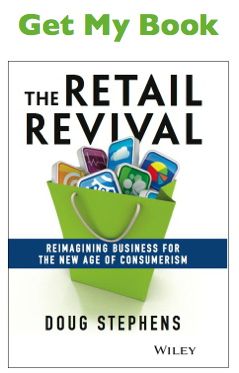
By Doug Stephens
There’s a dramatic and strangely under-editorialized reality taking shape in retail. One that seems to be eluding even some of the industry’s most sophisticated retailers and brands.
It’s that until very recently the primary function, form and purpose of retail stores was to distribute products. Stores were the principle and in many cases the only means of availing distribution of products to a given market.
Consequently, the entire retail industry framework has been based on product sales from the store to the consumer, and the revenue it generates. Markets are planned by projecting store sales, retail leases are often based on store sales, and a retailer’s health and success is measured by tracking it on a same-store sales basis. Indeed, almost all in-store metrics of performance are based on sales (per square foot, per hour, per sales associate and so on) It’s all about the sale of product. And therein lies the problem.
In a post-Internet, post-mobile world of one click access, the distribution of products has all but ceased to be the issue. When one of something can be efficiently shipped to anyone, anywhere, the question of where the sale takes place is rapidly becoming moot. In other words, in the long-term, sales of product simply can’t be the primary strategic purpose or metric for the store.
Some of the world’s largest retailers are struggling with this jarring reality already. “Stack it high and watch it fly” has abruptly turned into “stack it low and hope it goes” as big box stores scramble to lower inventories in the face of flat or declining sales. The knee-jerk reaction among some is to simply downsize and marginalize the role of the store. Others are adopting the buzzword of omni-channel – resigning to the idea that all channels now act as one – which I would argue risks oversimplifying what’s really happening.
You see, what’s actually evolving is a new and far more complex role for the store, and online brands like Google, Bonobos and Warby Parker are affirming it, as they each embark on creating their own, branded, physical stores. They along with a growing number of other online pure-plays recognize that in order to “fully actualize” their brands, they need to animate a physical presence and visceral experience for their consumers, not to move products but more critically, to move hearts and minds – to sell the idea, essence and values of the brand – all of which has more traditionally been viewed as the role of media. Which brings us to a critical point.
The physical store is becoming media.
What used to be a distribution channel is becoming a media channel and likewise, media channels (television, magazines, radio, print advertising, social media etc.) are increasingly becoming the “store”. Virtual storefronts are cropping up in all forms of media. It’s entirely possible to buy products from a tweet, a Facebook post, a video or TV show. And each day, new integrations and applications are allowing us to buy, in a friction-free way, directly from media formats. Media is no longer merely a benign messaging vehicle but also an instant distribution channel. We need no longer rely on driving consumers to “the store” when we can now drive the store to the consumer – wherever and whenever they need that store to be.
So increasingly, the primary role of the store will not be to sell product but rather to deliver the most powerful, and emotionally galvanizing experience possible, to create an essential level brand affinity, trust and allegiance – none of which necessarily results in immediate, or location-specific revenue recognition.
It’s not that stores won’t sell products…
Of course, many will. But unlike today, where retail is a product-first, experience-second business, the reverse will increasingly be true. Product sales will simply ride on the back of remarkable experiences. Consequently, sales in general will steadily become a less meaningful or accurate measure of true store contribution and productivity. On the flip-side, media, which has always gotten away with using nebulous metrics, will now be held to entirely new standards for generating immediate, measurable sales – not merely impressions, “eyeballs” or awareness.
So, the binary debate over which channels are winning and which are losing  should come to an end. The fact is, all retail – online and offline – is becoming phy-gital. The physical store is becoming a powerful media channel and increasingly all forms of media are becoming the store. The result must be nothing other than a revolution in the way we plan, build, lease, measure and analyze the value of retail stores.
should come to an end. The fact is, all retail – online and offline – is becoming phy-gital. The physical store is becoming a powerful media channel and increasingly all forms of media are becoming the store. The result must be nothing other than a revolution in the way we plan, build, lease, measure and analyze the value of retail stores.
The store as we’ve known it, is being reinvented.
Book Doug to speak at your meeting or conference by clicking here.

